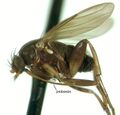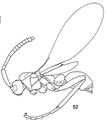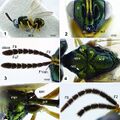Parasitoids
Parasitoids of ants may occupy a variety of ecological niches within their host ant colony. Most are internal parasites of ant brood and ant adults. Many are hymenopterans and dipterans as well as Strepsipterans. There is another subset of parasitoids that attack myrmecophiles and other organisms living with the ants (eg. Horismenus, Microdonophagus). Ant parasitoids are a possible agent for biocontrol of pest ants. Most parasitoids are obscure and poorly known. Some species attack ants as well as other insect hosts.
Acarina
Diptera
Phoridae
Acanthophorides
There are seven species in this genus
Acontistoptera
There are four species in this genus.
Aenigmatopoeus
There are seven species in this genus.
Apocephalus
The genus Apocephalus is a large group of phorid flies (332 species) that are often parasitoids of ants.
Auxanommatidia
There are eight species in this genus
Cataclinusa
There are two species in this genus
Chonocephalus
There are species in this genus
Commoptera
There are six species in this genus
Cremersia
There are 17 species in this genus.
Diocophora
There are fifteen species in this genus of Phoridae that attack ants.
Dohrniphora
Three species decapitate the head of Odontomachus
Ecitoptera
There are 14 species in this genus.
Euryplatea
There are two species in this genus.
Lucianaphora
There is a single species in this genus
Macrocerides
There are 11 species in this genus.
Megaselia
There are at least six species out of more than 1,800 species in this genus that attack ants.
Myrmosicarius
There are 18 species in this genus.
Neodohrniphora
There are 26 species in this genus.
Pseudacteon
There are 73 species in this genus.
Rhyncophoromyia
There are 11 species in this genus.
Vestigipoda
There are five species in this genus of myrmecophilous Phoridae.
Xanionotum
There are 13 species in this genus.
Hymenoptera
Chalcididae
Smicromorpha
Oecophylla smaragdina are host ants. There are eight species in this genus.
Diapriidae
The Diapriidae are a family of parasitoid wasps. These tiny insects have an average length of 2–4 mm and never exceed 8 mm. They typically attack larvae and pupae of a wide range of insects, especially flies. The about 2,300 described species in around 200 described genera are divided into three subfamilies, and the group has a global distribution.
- Loiácono, M.S., Margaría, C.B., Moreira, D.D.O. and Aquino, D. (2013) A New Species of Szelenyiopria Fabritius (Hymenoptera: Diapriidae), Larval Parasitoid of Acromyrmex subterraneus subterraneus (Forel) (Hymenoptera: Formicidae) from Brazil. Zootaxa, 3646, 228-234.
Tribe Diapriini Ashmead, 1893
Acanthopria
Apopria
Apropria coveri is found with Neivamyrmex opacithorax.
Asolenopsia
Associated with ecitonini ants of genus Eciton, Labidus and Neivamyrmex.
Auxopaedeutes
Basalys
Several species were reared from various dipterous hosts, and some were collected in ant nests. Associated with Linepithema humile.
Bruesopria
Doliopria
Doliopria is restricted to the New World, with only a few species in the Nearctic region and with a high number of undescribed species in tropical America. Associated with ecitonini and attini ants.
Ecitovagus
Ecitovagus gibbus is associated with Neivamyrmex nigrescens (Cresson) in Arizona; dealated female individuals were observed in raid columns of ants during crepuscular and night time observations. The wasps resemble ants, not only in size and color but also in movements, making distinguishing difficult. True lytic alectomy occurs in E. gibbus.
Mimopria
There are six species in this genus.
Mimopriella
Members of Mimopriella are closely associated with various ants.
Myrmecopria
Are associated with army ants (Neivamyrmex)
Neivapria
Neivapria is recognized by the following peculiar character states: general shape of head (occiput, postgenal keel, sculpture), sculpture of metapleuron, shape of petiole, and tuft of hairs on S2. Neivapria resembles Asolenopsia in some cephalic character states; however it remains a rather isolated genus because of many peculiarities.
Notoxoides
Members of Notoxoides display some of the most advanced associations with ants. So far, ants of genera Neivamyrmex and Eciton (Ecitonini) were recorded as hosts
Oxypria
Host ants are in the genera Eciton and Trachymyrmex.
Plagiopria
Found with ants in the genus Plagiolepis.
Townesella
Solenopsia
Szelenyiopria
Wide distribution from Argentina to Guatemala. There are six described species in this genus.
Trichopria
Associated with the “fire ant,” Solenopsis richteri Forel and endoparasitoid of Acromyrmex lobicornis. Several species were found in ant nests; some are aquatic or semiaquatic in habits.
Tribe Spilomicrini Ashmead, 1893
Bruchopria
There are two species in this genus.
Mannomicrus
A single species found with Formica subcyanea in Mexico.
Pentapria
A single species associated with Solenopsis saevissima in Argentina.
Spilomicrus
Encyrtidae
Arketypon
There is a single species found with ants.
Blanchardiscus
There is a single myrmecophilous species in this parasitic genus.
Eucharitidae
Eucharitidae parasitize the immature stages of Formicidae and are among the most diverse hymenopteran parasitoids of eusocial insects. Females are oviparous and proovigenic and lay their eggs inside or on plant tissues, either individually or in masses. They oviposit away from the host, with the active first instar larva (planidium) responsible for getting into the ant nest through various associations with foraging adult ants. Once in contact with the larval ant host, the planidium either remains as an external parasite or burrows into the host. Upon pupation of the host, the larva migrates to the ventral region of the thorax, just posterior to the legs of the newly formed pupa, then resumes development through two additional instars. The adults emerge and leave the nest on their own or may be carried by the ants and deposited in the accumulation of colony waste.
Worldwide, approximately 700 Eucharitidae species attack five subfamilies across the ant phylogeny.
Akapalinae
Akapalinae Bouček, 1988: 517. Type species: Akapala Girault.
Akapala
There are two Australian species in this genus.
Eucharitinae
Eucharitinae is a subfamily of chalcid wasps in the family Eucharitidae with 50 genera. Eucharitid Wasps biology and host ants.
Ancylotropus
There are five species in this genus which are Parasitoids of ants.
Apometagea
There is a single species in this genus.
Athairocharis
There are two species in this genus which are Parasitoids of ants in the genus Anoplolepis.
Austeucharis
There are thirteen species in this genus which are Parasitoids of ants. Host ants are Myrmecia.
Babcockiella
There are four species in this genus.
Carletonia
There is a single species in this genus. Specimens collected from Costa Rica and Panama.
Chalcura
There are twenty eight species in this genus.
Cherianella
There are seven species in this genus.
Colocharis
There are three species in this genus.
Cyneucharis
There is a single species in this genus.
Dicoelothorax
There are two species in this genus which are Parasitoids of ants. Host ants: Ectatomma brunneum
Dilocantha
There are five species in this genus which are Parasitoids of ants.
Eucharis
There are forty six species in this genus.
Eucharissa
There are six species in this genus, all are from South Africa.
Galearia
There are two species in this genus. From Argentina and Brazil.
Hydrorhoa
There are seven species in this genus.
Isomerala
There are three species in this genus.
Kapala
There are sixteen species in this genus.
Lasiokapala
There are two species in this genus.
Latina
There are four known species of Latina with three known in Argentina and one from Venezuela. Like all members of the Euchratidae, Latina wasps are ant parasitoids. The wasp lays eggs on the undersides of leaves near the nests of Ponerine ants. Within a few days the eggs hatch into planidial larvae that are mobile and can leap. They enter the ant colony, most likely being carried by, or riding on, the ants. Once inside, they seek out ant larvae as hosts. There the planidia attach to ant host larvae or prepupae where they feed. On completing their development they emerge, leaving the remains of the ant larva.
Leurocharis
There is a single species in this genus.
Lirata
There are six species in this genus.
Liratella
There is a single species in this genus from Paraguay.
Lophyrocera
There are six species in this genus.
Mateucharis
There are three species in this genus.
Mictocharis
There is a single species in this genus.
Mimistaka
There is a single species in this genus.
Neolirata
There are three species in this genus which are Parasitoids of ants.
Neolosbanus
There are sixteen species in this genus.
Neostilbula
There is a single species in this genus.
Obeza
There are eight described species in Obeza.
Palaeocharis
There is a single species from Baltic Amber.
Parakapala
There are three species in this genus.
Parapsilogastrus
There are five species in this genus.
Pogonocharis
There is a single species in this genus.
Pseudochalcura
There are fifteen species in this genus which are Parasitoids of ants.
Pseudometagea
There are eight species in this genus.
Psilocharis
There are nine species in this genus.
Rhipipalloidea
There are two species in this genus.
Saccharissa
There are four species in this genus.
Schizaspidia
There are twenty nine species in this genus.
Stilbula
There are twenty nine species in this genus. Camponotus is the suspected host ant for many species.
Stilbuloida
There are two species in this genus.
Striostibula
There is one species in this genus.
Substilbula
There are four species in this genus.
Thoracantha
This genus is comprised of three species.
Thoracanthoides
There is a single species in this genus.
Tricoryna
There are fifteen species from Australia.
Zulucharis
There are seven species in this genus. Reared from cocoons of Camponotus sp..
Gollumiellinae
Gollumiellinae are unique in that they hook their eggs onto the plants and connect a ropey secretion to them, which stand erect. This acts as an attraction mechanism for Paratrechina ants. Gollumiellinae larvae burrow into the hosts' thoraces and feed there. The rest of its life cycle is similar to the aforementioned life cycle of eucharitids. Two Indo‐Pacific genera are included here.
Anorasema
There are two species in this genus.
Gollumiella
There are nine species in this genus.
Oraseminae
Oraseminae constitutes one of the major lineages of the family Eucharitidae, with the estimated number of species approaching 200 (Heraty 2002), all of which are parasitoids of ants (Hymenoptera: Formicidae). There are verified host records of Oraseminae attacking six genera in the ant subfamily Myrmicinae and dubious records on Ecitoninae and Formicinae. In all known Oraseminae, the planidium burrows just under the larval cuticle, usually on the dorsal thoracic region, and the larva then feeds and expands (sometimes over 100× its original size) without changing instars (Wheeler, 1907; Heraty, 2000). After the ant pupates, the wasp migrates to the ventral region of the thorax and develops through its second and third instars, which results in a desiccated living ant pupa that cannot continue its development (Wheeler, 1907; Clausen, 1940a; Heraty & Murray, 2013). All myrmicine ants have naked pupae (lacking cocoons), and thus, parasitoid larvae are exposed throughout their development. The exact means by which the planidia infiltrate the ant colony have never been directly observed; however, it is presumed that planidia gain access by targeting one of the ants’ food sources. Proposed mechanisms include random attachment to foraging ants, phoretic attachment to an intermediate host (prey item) such as immature leafhoppers or thrips, or aggregating near or in extrafloral nectaries (EFNs) of plants and being picked up by feeding ant workers (Clausen, 1941; Das, 1963; Wilson & Cooley, 1972; Johnson et al., 1986; Carey et al., 2012; Herreid & Heraty, 2017). In the latter case (and perhaps all cases), the planidia are proposed to be transported by the adult ants within the infrabuccal pocket in their mouthparts and passed to the ant larvae via trophallaxis (Herreid & Heraty, 2017). With any of these nest infiltration methods, a tight tritrophic association is required, in which the plant has to be available and a suitable host for both the wasp and foraging ants.
Australosema
There are four species in this genus.
Cymosema
There are two species in this genus.
Hayatosema
There are eight species in this genus.
Ibitya
There are two species in this genus from Madagascar.
Indosema
There is a single species in this genus.
Ivieosema
There are four species in this genus.
Leiosema
There are two species in this genus.
Losbanus
There are five species in this genus.
Matantas
There is a single species in this genus from New Caledonia.
Orasema
There are 112 species in this genus.
Orasemorpha
There are nine species in this genus.
Timioderus
There are five species in this genus.
Zuparka
There are two species in this genus which are Parasitoids of ants. There are two species in this genus from Madagascar.
Eulophidae
The Eulophidae are a large family of hymenopteran insects, with over 4,300 described species in some 300 genera.
Eulophids are separable from most other Chalcidoidea by the possession of only four tarsomeres on each leg, a small, straight protibial spur (as opposed to the larger, curved one in most other chalcidoids), and by antennae with two to four funicle segments and at most 10 antennomeres.
Entedoninae
Entedoninae is a subfamily of wasps in the family Eulophidae which includes over 90 genera. Only a few species are associated with ants.
There are two species associated with ants in this parasitoid genus of more than 400 species.
Microdonophagus
There are three species in this parasitoid genus.
Myrmokata
There is a single species in this parasitoid genus of Eulopidae.
Pediobius
There is a single species in this parasitoid genus of Eulopidae.
Eurytomidae
Unlike most chalcidoids, the larvae of many are phytophagous (feeding in stems, seeds, or galls), while others are more typical parasitoids, though even then the hosts are usually found within plant tissues. They are found throughout the world in virtually all habitats, and a few are considered pests. They tend to be dull and not metallic, and heavily punctured, with very thick, collar-like pronota.
Camponotophilus
Strepsiptera
Caenocholax
Lychnocolax
Myrmecolax
Stichotrema
REFERENCES
- Baker, Austin J., Heraty, John M. (2020): The New World ant parasitoid genus Orasema (Hymenoptera: Eucharitidae). Zootaxa 4888 (1): 1-84, DOI: https://doi.org/10.11646/zootaxa.4888.1.1
- C. P. Clausen, “The immature stages of the Eucharidae,” Proceedings of the Entomological Society of Washington, vol. 42, no. 8, pp. 161–170, 1940.
- C. P. Clausen, “The oviposition habits of the Eucharidae (Hymenoptera),” Journal of theWashington Academy of Sciences, vol. 30, no. 12, pp. 504–516, 1940.
- Gahan, A.B. A contribution to the knowledge of the Eucharidae (Hymenoptera: Chalcidoidea). JOURBOOK: Proceedings of the United States National Museum VOLUME: 88 PAGES: 425-458. (1940).
- Gumovsky, A. Taxonomic notes on the entedonine genera Rhynchentedon and Pediobomyia (Hymenoptera: Chalcidoidea: Eulophidae) with the description of a new species.Zool. Med. Leiden 75 (14), 24.xii.2001: 229-238, figs 1-7.
- Hansson, Christer (2009): The genus Microdonophagus Schauff (Hymenoptera: Eulophidae), with description of a new species. Zootaxa 2200: 54-60, DOI: 10.5281/zenodo.189612
- Hansson, Christer, Lachaud, Jean-Paul, Perez-Lachaud, Gabriela (2011): Entedoninae wasps (Hymenoptera, Chalcidoidea, Eulophidae) associated with ants (Hymenoptera, Formicidae) in tropical America, with new species and notes on their biology. ZooKeys 134: 65-82
- Heraty, J.M. Classification and evolution of the Oraseminae in the Old World, including revision of two closely related genera of Eucharitinae (Hymenoptera: Eucharitidae). JOURBOOK: Life Sciences Contributions, Royal Ontario Museum VOLUME: 157 PAGES: vii+174pp. (1994).
- Heraty, J.M. 2017. Catalog of World Eucharitidae, 2017. Electronic publication
- Lachaud, J.P., Lenoir, A. and Hughes, D. P. 2013. Ants and their parasites 2013. Psyche 2013: 1-5.
- Murray, E.A., Carmichael, A.E. & Heraty, J.M. (2013) Ancient host shifts followed by host conservatism in a group of ant parasitoids. Proceedings of the Royal Society of London. Series B: Biological Sciences, 280, 20130495.
- Quevillon, L. 2018. THE ECOLOGY, EPIDEMIOLOGY, AND EVOLUTION OF PARASITES INFECTING ANTS (HYMENOPTERA: FORMICIDAE). Ph.D. Dissertation, The Pennsylvania State University.
- Schauff, M.E. 1986. Microdonophagus, a new Entedonine genus (Hymenoptera: Eulophidae) from Panama. Proceedings of the Entomological Society in Washington, 88:167-170
- Torrens, J. 2013. A Review of the Biology of Eucharitidae (Hymenoptera: Chalcidoidea) from Argentina. Psyche Volume 2013, Article ID 926572, 14 pages
- Torréns, J., Heraty, J.M., Fidalgo, P. 2008. Biology and description of a new species of Lophyrocera Cameron (Hymenoptera: Eucharitidae from Argentina. Zootaxa 1871: 56-62.
- Torréns, J., Heraty, J.M., Murray, E.A., & Fidalgo, P. (2016). Biology and phylogenetic placement of a new species of Lasiokapala Ashmead from Argentina (Hymenoptera: Eucharitidae). Systematic Entomology, 41.
| ||||||||||||||||||||||||||||||||||||||||||||||||||||||||





























































































